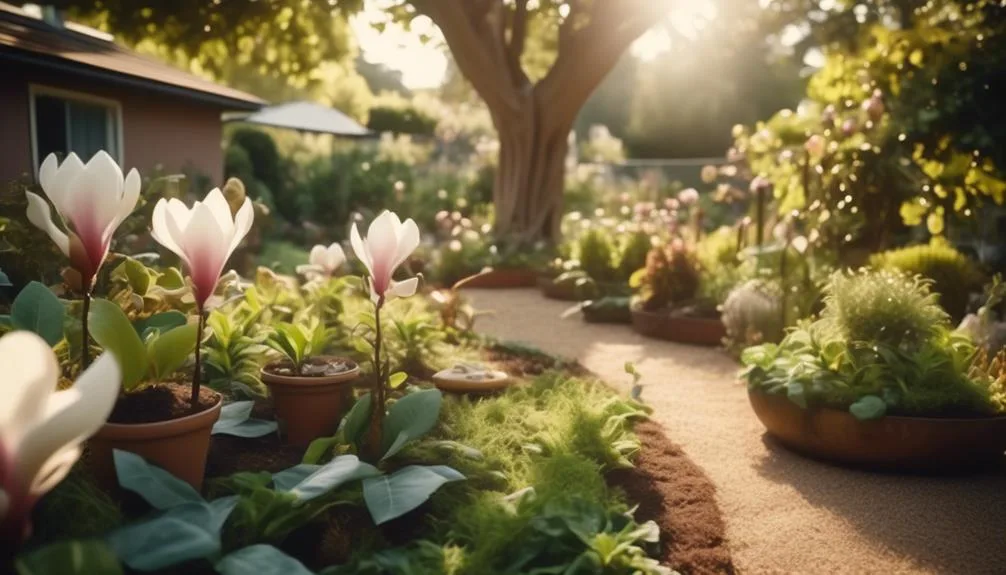Magnolia trees have stood the test of time for over 95 million years, making them a fascinating addition to permaculture gardens.
Their beauty and ecological benefits make them a valuable part of the garden ecosystem.
Understanding how magnolia trees fit into permaculture design is key to creating a thriving and diverse environment.
Let's explore the role of magnolia trees, from their relationships with other plants to their contribution to the garden's resilience and biodiversity.
Benefits of Magnolia Trees in Permaculture
Magnolia trees offer a multitude of benefits in a permaculture garden, providing not only stunning beauty but also contributing to the ecosystem's health and diversity.
These majestic trees aid in soil enrichment through their fallen leaves, which decompose to create nutrient-rich soil. Their large, glossy leaves also provide shade, keeping the soil cool and moist, promoting a healthy microclimate for other plants.
Additionally, their exquisite flowers and aromatic fragrance attract a variety of pollinators, such as bees and butterflies, enhancing the garden's biodiversity.
The aesthetic appeal of magnolia trees is undeniable, adding a touch of elegance and charm to any permaculture garden. Their broad canopy and lush foliage create a tranquil and inviting atmosphere, making them a perfect focal point for relaxation and contemplation within the garden.
Ideal Growing Conditions for Magnolia Trees
To ensure optimal growth and health for magnolia trees in your permaculture garden, it's essential to provide the ideal growing conditions that support their unique needs and characteristics.
Magnolia tree varieties vary in their soil preferences, but most thrive in well-draining, slightly acidic soil with a pH of 5.0-6.5. When choosing a location for your magnolia trees, consider the soil requirements of the specific variety you have.
For instance, deciduous magnolias typically prefer moist, rich, and well-drained soil, while evergreen magnolias often thrive in slightly acidic and well-drained soil. It's important to avoid waterlogged or compacted soil, as this can lead to root rot and other health issues for the tree.
Companion Plants for Magnolia Trees
Incorporating companion plants that complement the unique needs and characteristics of magnolia trees can enhance the overall health and beauty of your permaculture garden. Consider these companion planting options for your magnolia trees:
- Soil Companions: Plants like ferns and hostas can thrive in the dappled shade provided by magnolia trees, helping to maintain soil moisture and preventing erosion.
- Pest Control: Integrate insect-repelling plants such as marigolds and garlic around your magnolia trees to naturally deter pests and protect the health of the magnolias.
- Flowering Shrubs and Ground Cover: Utilize complementary flowering shrubs like azaleas and camellias to create a stunning visual display around the base of the magnolia trees. Additionally, ground cover plants such as vinca or sweet woodruff can help to suppress weeds and retain soil moisture.
Maintenance and Care for Magnolia Trees
With a robust companion planting strategy in place, ensuring the health and vitality of your magnolia trees, it's essential to also understand the maintenance and care required to support their growth and longevity.
When it comes to pruning techniques, it's important to prune your magnolia trees in late winter or early spring before new growth begins. Focus on removing dead or damaged branches, as well as any crossing branches that could cause rubbing and lead to potential disease entry points.
Additionally, fertilization methods are crucial for the overall health of your magnolia trees. Use a slow-release, balanced fertilizer in early spring to support healthy growth and flowering. Avoid high-nitrogen fertilizers, as they can promote excessive foliage growth at the expense of flowers.
Integrating Magnolia Trees Into Permaculture Design
Considering the unique attributes and growth patterns of magnolia trees, it's important to carefully integrate them into your permaculture design to maximize their benefits and contribute to the overall ecosystem. When it comes to integrating magnolia trees into your permaculture garden, here are a few key points to consider:
- Tree Placement: Choose a location that provides adequate space for the magnolia tree to mature without overcrowding other plants. Consider its eventual height and spread to ensure it doesn't shade out other sun-loving plants in your garden.
- Soil Preparation: Magnolia trees thrive in well-drained, slightly acidic soil. Incorporate organic matter such as compost or leaf mulch into the soil to improve its texture and fertility, promoting healthy growth.
- Companion Planting: Integrate beneficial companion plants around the magnolia tree to create a mutually supportive ecosystem, attracting beneficial insects and enhancing biodiversity.
Conclusion
Incorporating magnolia trees into your permaculture garden can significantly enhance biodiversity and sustainability. Their striking flowers, shade, and wildlife-attracting abilities make them a valuable addition.
By providing the right conditions and maintenance, these majestic trees can thrive, contributing to a resilient and diverse landscape. Consider their role in creating a more sustainable ecosystem and a healthier garden overall.

My interest in trees started when I first saw the giant sequoias in Yosemite.
I was a teenager then, and I remember thinking, “I need to learn more about this.”
That moment stuck with me.
A few years later, I went on to study forestry at Michigan Tech.
Since graduating, I’ve worked in a mix of hands-on tree care and community education.
I’ve spent over ten years helping people understand how to plant, maintain, and protect the trees in their neighborhoods.
I don’t see trees as just part of the landscape.
They are living things that make a real difference in our daily lives.
